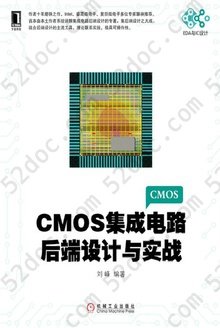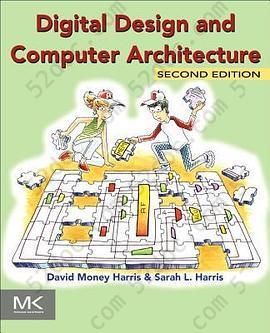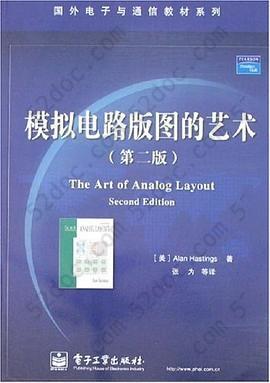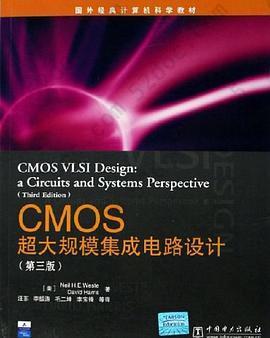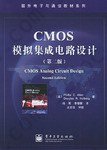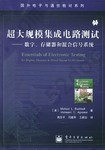注重体验与质量的电子书资源下载网站
分类于: 云计算&大数据 设计
简介

Semiconductor Manufacturing Handbook 豆 0.0分
资源最后更新于 2020-11-21 02:44:07
作者:Hwaiyu Geng
出版社:McGraw-Hill Education
出版日期:2017-01
ISBN:9781259587696
文件格式: pdf
标签: IC
简介· · · · · ·
Preface
As engineers, managers, researchers, professors, or students, we are all facing increasing challenges in a cross-functional environment. For each manufacturing problem or project, we must ask these questions: What are the unknowns, available data, conditions, and feasible alternatives to validate and find an optimum solution plan? How does one apply technical knowledge ...
目录
Contents in Brief
PART 1 SEMICONDUCTOR MANUFACTURING FUNDAMENTALS
PART 2 FRONT-END-OF-LINE PROCESSES
PART 3 BACK-END-OF-LINE PROCESSES
PART 4 TECHNOLOGIES FOR FLEXIBLE HYBRID ELECTRONICS AND LARGE-AREA ELECTRONICS
PART 5 PROCESS GASES AND CHEMICALS
PART 6 OPERATIONS, EQUIPMENT, AND FACILITIES
Technical Advisory Board
Contributors
Foreword
Preface
Acknowledgments
【PART 1 SEMICONDUCTOR MANUFACTURING FUNDAMENTALS】
Chapter 1. Semiconductor Manufacturing, the Internet of Things, and Sustainability Hwaiyu Geng
1.1 Introduction
1.2 Moore’s Law
1.3 Integrated Circuits and Design
1.4 How a Microchip Is Made
1.5 The Internet of Things World
1.6 Semiconductor Market Opportunities in the IoT World
1.7 Sustainability
1.8 Conclusion
1.9 References
1.10 Further Reading
Chapter 2. Nanotechnology and Nanomanufacturing: From Silicon to New Carbon-Based Materials and Beyond Michael A. Huff
2.1 Introduction
2.2 What Is Nanotechnology?
2.3 Why Nanotechnology Is Important
2.4 History of Nanotechnology
2.5 Fundamental Methods of Fabrication at the Nanoscale
2.6 Nanotechnology Metrology
2.7 Nanotechnology Manufacturing
2.8 Applications and Markets
2.9 Implications and Regulations
2.10 Conclusions
2.11 References
Chapter 3. Fundamentals of FinFET and Recent Advances in Nanoscale Silicide Formation L. P. Ren, Yi-Chia Chou, and K. N. Tu
3.1 Overview
3.2 Fundamentals of FinFET
3.3 Recent Advances in Nanoscale Silicide Formation
3.4 Conclusion
3.5 References
Chapter 4. Foundations of Microsystems Manufacturing: An Empowering Technology for the IoT Michael A. Huff
4.1 The Definition of MEMS and Microsystems Technologies
4.2 Why Microsystems Are Important
4.3 Technology Fundamentals of Microsystems
4.4 How Microsystems Are Made
4.5 Future Trends
4.6 Conclusions
4.7 References
Chapter 5. Physical Design for High-Performance, Low-Power, and Reliable 3D Integrated Circuits Ankur Srivastava and Tiantao Lu
5.1 Introduction
5.2 3D IC Design Flow
5.3 Physical Challenges and Physical Design Tools for 3D IC
5.4 Physical Design Solutions for 3D IC
5.5 Conclusions and Future Developments
5.6 References
【PART 2 FRONT-END-OF-LINE PROCESSES】
Chapter 6. Epitaxy Jamal Ramdani
6.1 Introduction
6.2 Safety and Environmental Health
6.3 Future Epitaxy Trends
6.4 Conclusion
6.5 References
6.6 Suggested Reading
Chapter 7. Thermal Processing: Anneals, RTP, and Oxidation David L. O’Meara
7.1 Introduction
7.2 Thermal Processing
7.3 Rapid Thermal Processing Considerations
7.4 Oxidation
7.5 Manufacturing Considerations
7.6 Conclusion
7.7 Acknowledgments
7.8 References
7.9 Further Reading
Chapter 8. Microlithography Chris A. Mack
8.1 The Lithographic Process
8.2 Image Formation in Optical Lithography
8.3 Photoresist Chemistry
8.4 Linewidth Control
8.5 Overlay Control
8.6 The Limits of Optical Microlithography
8.7 Further Reading
Chapter 9. Etching Nandita DasGupta
9.1 Introduction
9.2 Wet Etching
9.3 Dry Etching
9.4 Summary and Conclusion
9.5 Acknowledgments
9.6 References
9.7 Further Reading
Chapter 10. Ion Implantation Bo Vanderberg and Mike Ameen
10.1 Overview
10.2 Overview of Modern Ion Implantation Equipment
10.3 Ion Implantation Applications
10.4 Outlook
10.5 References
Chapter 11. Introduction to Physical Vapor Deposition Florian Solzbacher
11.1 Motivation and Key Properties
11.2 Fundamentals of PVD Processes
11.3 Vacuum Evaporation
11.4 Evaporator Equipment
11.5 Layers Deposited Using Evaporation and Their Properties
11.6 Sputtering
11.7 Sputter Equipment
11.8 Layers Deposited Using Sputtering
11.9 References
Chapter 12. Chemical Vapor Deposition Bin Dong, M. Sky Driver, and Jeffry A. Kelber
12.1 Introduction
12.2 History
12.3 Conformal CVD Films and Void-Free Feature Filling
12.4 Thermodynamic and Kinetic Considerations
12.5 The Future: Emerging Electronic Materials
12.6 References
Chapter 13. Atomic Layer Deposition Eric T. Eisenbraun
13.1 Introduction
13.2 Primary Commercial Applications for ALD
13.3 ALD for Front End of the Line Semiconductor Manufacturing Applications
13.4 Developing the ALD Process
13.5 Considerations in Selecting an Appropriate Precursor and Reactant for ALD
13.6 Hardware and Process Innovations to Increase Growth Rate in ALD
13.7 The Use of Plasmas in ALD Processes
13.8 Hardware Considerations for ALD Processing
13.9 Reversing the Chemistry: Atomic Layer Etching
13.10 References
13.11 Further Reading
Chapter 14. Electrochemical Deposition John Klocke
14.1 Introduction
14.2 Fundamentals of Electrochemical Deposition
14.3 Application of Electrochemical Deposition
14.4 Future Trends
14.5 Summary
14.6 References
Chapter 15. Fundamentals of Chemical Mechanical Planarization Gautam Banerjee
15.1 Introduction
15.2 Why Is It Important to Understand the Fundamental Aspects of CMP?
15.3 Birth of CMP
15.4 Polishing versus Planarization
15.5 The CMP Application Process
15.6 Mechanism of CMP Process
15.7 CMP Consumables
15.8 CMP Interactions
15.9 Post-CMP Cleaning
15.10 Summary
15.11 Acknowledgments
15.12 References
Chapter 16. AFM Metrology Ardavan Zandiatashbar
16.1 Introduction
16.2 Metrology: Fundamentals and Principles
16.3 AFM Technique and Fundamentals
16.4 Automated AFM for In-Line Metrology
16.5 Maintenance and Calibration
16.6 Conclusion
16.7 References
16.8 Further Reading
【PART 3 BACK-END-OF-LINE PROCESSES】
Chapter 17. Wafer Thinning and Singulation Youngsuk Kim, Sumio Masuchi, Noriko Ito, and Miyuki Hirose
17.1 Introduction
17.2 Thinning Technology Overview: Grinding
17.3 Thinning Process and Equipment
17.4 Thinning Technology, Stress Relief, and Other Requirements
17.5 Singulation Technology Overview and Blade Dicing
17.6 Singulation Process and Equipment
17.7 Laser Technology
17.8 DBG and SDBG
17.9 3D Integration with Through Silicon Via
17.10 References
Chapter 18. Packaging Michael Töpper and Dietrich Tönnies
18.1 Introduction
18.2 Packaging Evolution
18.3 Wafer Bumping and Redistribution Technology
18.4 Case Studies
18.5 Optoelectronics and MEMS Packaging
18.6 References
18.7 Further Reading
Chapter 19. Bonding Fundamentals Ivy Qin
19.1 Introduction
19.2 Wire Bonding Equipment
19.3 Wire Bonding Process
19.4 Conclusions and Future Developments
19.5 References
Chapter 20. Interconnects Reliability Roey Shavivs
20.1 Introduction
20.2 Electromigration
20.3 Stress Migration
20.4 Dielectric Breakdown
20.5 Conclusion
20.6 References
20.7 Further Reading
Chapter 21. Automatic Test Equipment A. T. Sivaram
21.1 Automatic Test Equipment Introduction
21.2 ATE History
21.3 Digital Tester
21.4 Linear Tester
21.5 Mixed-Signal Tester
21.6 Memory Tester
21.7 Flash Memory Tester
21.8 RF Tester
21.9 SoC Tester
21.10 Burn-In Tester
21.11 Design Diagnostic Equipment
21.12 ATE Market Size
21.13 ATE Architecture
21.14 Architecture of a Flash Memory Tester
21.15 Architecture of an RF System
21.16 Architecture of a SOC Tester
21.17 DFT Test Techniques
21.18 Emergence of Cloud-Based DFT Tester
21.19 ATE Specifications
21.20 ATE Data Formats
21.21 Manufacturers and ATE Models
21.22 Future ATE Directions
21.23 Acknowledgments
21.24 Further Reading
【PART 4 TECHNOLOGIES FOR FLEXIBLE HYBRID ELECTRONICS AND LARGE-AREA ELECTRONICS】
Chapter 22. Printed Electronics: Principles, Materials, Processes, and Applications Kan Wang, Yung-Hang Chang, Ben Wang, and Chuck Zhang
22.1 Introduction to Printed Electronics
22.2 Printed Electronics: Principles and Fundamentals
22.3 Materials for Printed Electronics
22.4 Manufacturing Processes for Printed Electronics
22.5 Major Challenges and Potential Solutions
22.6 Application Cases
22.7 Conclusion
22.8 References
Chapter 23. Flexible Hybrid Electronics Rich Chaney
23.1 Introduction
23.2 What Are Flexible Hybrid Electronics?
23.3 Why Are Flexible Hybrid Electronics Needed?
23.4 How Are Flexible Hybrid Electronics Made?
23.5 Conclusions and Future Trends
23.6 References
Chapter 24. Flexible Electronics Dan Xie and Yilin Sun
24.1 Flexible Applications
24.2 Key Materials for Flexible Circuits
24.3 Manufacturing Technology for Flexible Circuits
24.4 Conclusions and Future Trends
24.5 References
24.6 Further Reading
Chapter 25. RF Printed Electronics: Communication, Sensing, and Energy Harvesting for the Internet of Things and Smart Skin Applications Bijan K. Tehrani and Manos (Emmanouil) M. Tentzeris
25.1 Introduction
25.2 Printing Processes and Materials
25.3 Printed RF Applications
25.4 Conclusion
25.5 References
Chapter 26. Printing of Nanoscale Electronics and Power Electronics Cihan Yilmaz and Ahmed Busnaina
26.1 Introduction
26.2 Nanoscale Directed Assembly and Transfer
26.3 Applications in Power Electronics
26.4 References
Chapter 27. 3D Interconnects in Flexible Electronics Cihan Yilmaz and Ahmed Busnaina
27.1 Introduction
27.2 Directed Assembly of Nanoparticles
27.3 3D Interconnect Fabrication Process
27.4 Material Characterization
27.5 Electrical Characterization
27.6 Capabilities of the Fabrication Process
27.7 Comparison with Other Approaches
27.8 References
Chapter 28. Materials for the Manufacturing of an Inkjet Printed Touch Sensor Nesrine Kammoun, Christian Renninger, and Norbert Fruehauf
28.1 Introduction
28.2 Material and Process Optimizations
28.3 Additive Process Parameters
28.4 Touch-Panel Demonstrator
28.5 Conclusion
28.6 Acknowledgment
28.7 References
28.8 Further Reading
Chapter 29. Flat-Panel and Flexible Display Technology ChengChung Lee, Yung-Hui Yeh, Yuh-Zheng Lee, and David N. Liu
29.1 Introduction
29.2 Definitions
29.3 What Are the Fundamentals and Principles of Display?
29.4 What Is the Manufacturing Process?
29.5 Future Trends and Conclusions
29.6 Further Reading
Chapter 30. Photovoltaics Fundamentals, Manufacturing, Installation, and Operations Jun Zhuge
30.1 Introduction
30.2 Fundamentals of Photovoltaics
30.3 Photovoltaic Power Plant
30.4 Maintenance and Operation
30.5 Future Prospects of Photovoltaics
30.6 References
【PART 5 PROCESS GASES AND CHEMICALS】
Chapter 31. Gas Distribution Systems Kenneth Grosser, James McAndrew, and Tracey Jacksier
31.1 Introduction
31.2 Design Principles
31.3 Materials
31.4 Installation Specifications
31.5 Quality Assurance
31.6 Certification
31.7 Qualification/Commissioning
31.8 Tool Hookup
31.9 Operation and Maintenance
31.10 References
31.11 Further Reading
Chapter 32. Fundamentals of Ultrapure Water Vyacheslay (Slava) Libman
32.1 Introduction
32.2 UPW Production
32.3 UPW Distribution System
32.4 Analytical Methods and Techniques
32.5 UPW Challenges of the Semiconductor Industry
32.6 Recommendations for Reaching High-Quality UPW
32.7 Acknowledgments
32.8 References
Chapter 33. Process Chemicals, Handling, and Abatement Daniel Fuchs
33.1 Introduction
33.2 Important Chemical Hazard Terminology and Symbols
33.3 Process Chemicals Used in the Semiconductor Manufacturing Process
33.4 General Handling of Process Chemicals and Slurries
33.5 Logistics
33.6 Analytical Validation
33.7 Abatement
33.8 Conclusion
33.9 Acknowledgments
33.10 References
33.11 Further Reading
Chapter 34. Filtration Barry Gotlinsky
34.1 Chemical Filtration
34.2 Ultrapure Water Filtration
34.3 Lithography Filtration
34.4 Chemical Mechanical Polishing Filtration
34.5 Gas Filtration
34.6 Use of Filtration as a Defect Analysis Tool
34.7 References
Chapter 35. Chemical and Slurry Handling Systems Kristin Cavicchi
35.1 Introduction
35.2 Important Terms
35.3 History of Chemical and Slurry Handling Systems
35.4 Chemical and Slurry Handling Equipment
35.5 System Purity
35.6 Conclusion
35.7 Acknowledgments
35.8 References
【PART 6 OPERATIONS, EQUIPMENT, AND FACILITIES】
Chapter 36. Yield Management Dieter Rathei
36.1 Introduction
36.2 Fundamentals of Yield Management
36.3 Methodology: Defects, Data Mining, and Enhancements
36.4 Software
36.5 Conclusions and Future Developments
36.6 References
36.7 Further Reading
Chapter 37. CIM and Factory Automation Clint Haris
37.1 Introduction
37.2 Semiconductor Factory Software
37.3 Semiconductor AMHS
37.4 The Design of an AMHS
37.5 Operational Considerations
37.6 Future Trends
37.7 Further Reading
Chapter 38. MES Fundamentals Julie Fraser
38.1 The Role and Purpose of MES
38.2 Evolution of MES in Semiconductors
38.3 MES Scope and Functions
38.4 Modern MES Characteristics and Foundations
38.5 MES Project Considerations
38.6 Further Reading
Chapter 39. Advanced Process Control Raymond van Roijen
39.1 Introduction
39.2 Statistical Process Control
39.3 Fault Detection and Classification
39.4 Virtual Metrology
39.5 Future Trends
39.6 Resources and Vendors
39.7 References
Chapter 40. Airborne Molecular Contamination Chris Muller
40.1 Introduction to Chemical Contamination and Definition of AMC
40.2 Classification of AMC
40.3 AMC Control Considerations
40.4 Implementing AMC Control
40.5 Gas-Phase Air Filtration Principles
40.6 Dry-Scrubbing Air Filtration Media
40.7 Chemical Filtration Equipment Designs
40.8 AMC Monitoring
40.9 AMC Control Application Areas
40.10 AMC Control Specifications and Standards
40.11 Specifying an AMC Control System
40.12 Final Considerations
40.13 Summary
40.14 References
40.15 Information Resources
40.16 Appendix: Abbreviations for Referenced Sampling Devices and Analysis Methods
Chapter 41. ESD Controls in Cleanroom Environments Larry Levit
41.1 Electrostatic Charge in Semiconductor Cleanrooms
41.2 Problems Resulting from Charge in Cleanrooms
41.3 Static Charge Generation
41.4 Insulators versus Conductors
41.5 Cleanroom Electrostatic Management
41.6 Air Ionization for Static Charge Control
41.7 Electrostatic Measurement
41.8 Air Ionizer Applications
41.9 Conclusions
41.10 References
Chapter 42. Vacuum Systems Michael R. Czerniak
42.1 Introduction
42.2 Vacuum Pumps
42.3 Point-of-Use Abatement
42.4 Conclusion and Future Trends
42.5 Acknowledgments
42.6 References
42.7 Further Reading
Chapter 43. Control of RF Plasma Processing David J. Coumou
43.1 Introduction
43.2 Fundamentals of Plasma Generation and Process Control
43.3 Process Control and Diagnostics
43.4 Advanced Plasma Processing Control
43.5 Properties of Dry Etch Process
43.6 Future Trends and Conclusions
43.7 References
Chapter 44. IC Manufacturing Equipment Parts Cleaning Technology: Fundamentals and Applications Ardeshir J. Sidhwa and Dave Zuck
44.1 A Historic Perspective on Outsourced Part Cleaning
44.2 Past, Current, and Future Technologies/Applications
44.3 Equipment Parts Cleaning Technology Fundamentals and Applications
44.4 Part Surface Treatment Technologies and Their Effects on Process Performance
44.5 The Plasma Coating Process
44.6 Summary
44.7 Acknowledgments
44.8 References
Chapter 45. Equipment Design Challenges due to Increasing Hazards and Regulations Mark Fessler
45.1 Introduction: “The Product Compliance Puzzle”
45.2 The Fundamentals of Product Compliance: “What Must Be Done?”
45.3 Engineering Department Suggestions: “How Can We Do This Better?”
45.4 Conclusion: “Solving the Puzzle”
45.5 References
Chapter 46. Cleanroom Design and Construction Richard V. Pavlotsky
46.1 Introduction
46.2 Cleanroom Standards and Certification
46.3 Types of Cleanrooms
46.4 Airflow Layouts and Patterns
46.5 Air Changes
46.6 Elements of a Cleanroom
46.7 Ceiling Systems
46.8 Wall Systems
46.9 Floor Systems
46.10 Environmental Requirements
46.11 Process Contamination Control
46.12 Vibration and Noise Control
46.13 Magnetic and Electromagnetic Flux
46.14 Electrostatic Charge of Air and Surfaces
46.15 Life Safety
46.16 Computational Fluid Dynamics
46.17 Cleanroom Design and Construction
46.18 Further Reading
46.19 Professional Associations
Chapter 47. Vibration and Noise Design Michael Gendreau and Hal Amick
47.1 Introduction
47.2 Measurement Methodologies and Criteria
47.3 Vibration and Noise Sources
47.4 Foundation and Structural Design
47.5 Vibration and Noise Control in the Mechanical/Electrical/Process (MEP) Design
47.6 Acoustical Design
47.7 Tool Hook-Up
47.8 Purposes and Timing of Facility Vibration Surveys
47.9 Maturation of the Vibration and Noise Environment
47.10 Future Trends and Special Cases
47.11 Acknowledgments
47.12 References
Index
PART 1 SEMICONDUCTOR MANUFACTURING FUNDAMENTALS
PART 2 FRONT-END-OF-LINE PROCESSES
PART 3 BACK-END-OF-LINE PROCESSES
PART 4 TECHNOLOGIES FOR FLEXIBLE HYBRID ELECTRONICS AND LARGE-AREA ELECTRONICS
PART 5 PROCESS GASES AND CHEMICALS
PART 6 OPERATIONS, EQUIPMENT, AND FACILITIES
Technical Advisory Board
Contributors
Foreword
Preface
Acknowledgments
【PART 1 SEMICONDUCTOR MANUFACTURING FUNDAMENTALS】
Chapter 1. Semiconductor Manufacturing, the Internet of Things, and Sustainability Hwaiyu Geng
1.1 Introduction
1.2 Moore’s Law
1.3 Integrated Circuits and Design
1.4 How a Microchip Is Made
1.5 The Internet of Things World
1.6 Semiconductor Market Opportunities in the IoT World
1.7 Sustainability
1.8 Conclusion
1.9 References
1.10 Further Reading
Chapter 2. Nanotechnology and Nanomanufacturing: From Silicon to New Carbon-Based Materials and Beyond Michael A. Huff
2.1 Introduction
2.2 What Is Nanotechnology?
2.3 Why Nanotechnology Is Important
2.4 History of Nanotechnology
2.5 Fundamental Methods of Fabrication at the Nanoscale
2.6 Nanotechnology Metrology
2.7 Nanotechnology Manufacturing
2.8 Applications and Markets
2.9 Implications and Regulations
2.10 Conclusions
2.11 References
Chapter 3. Fundamentals of FinFET and Recent Advances in Nanoscale Silicide Formation L. P. Ren, Yi-Chia Chou, and K. N. Tu
3.1 Overview
3.2 Fundamentals of FinFET
3.3 Recent Advances in Nanoscale Silicide Formation
3.4 Conclusion
3.5 References
Chapter 4. Foundations of Microsystems Manufacturing: An Empowering Technology for the IoT Michael A. Huff
4.1 The Definition of MEMS and Microsystems Technologies
4.2 Why Microsystems Are Important
4.3 Technology Fundamentals of Microsystems
4.4 How Microsystems Are Made
4.5 Future Trends
4.6 Conclusions
4.7 References
Chapter 5. Physical Design for High-Performance, Low-Power, and Reliable 3D Integrated Circuits Ankur Srivastava and Tiantao Lu
5.1 Introduction
5.2 3D IC Design Flow
5.3 Physical Challenges and Physical Design Tools for 3D IC
5.4 Physical Design Solutions for 3D IC
5.5 Conclusions and Future Developments
5.6 References
【PART 2 FRONT-END-OF-LINE PROCESSES】
Chapter 6. Epitaxy Jamal Ramdani
6.1 Introduction
6.2 Safety and Environmental Health
6.3 Future Epitaxy Trends
6.4 Conclusion
6.5 References
6.6 Suggested Reading
Chapter 7. Thermal Processing: Anneals, RTP, and Oxidation David L. O’Meara
7.1 Introduction
7.2 Thermal Processing
7.3 Rapid Thermal Processing Considerations
7.4 Oxidation
7.5 Manufacturing Considerations
7.6 Conclusion
7.7 Acknowledgments
7.8 References
7.9 Further Reading
Chapter 8. Microlithography Chris A. Mack
8.1 The Lithographic Process
8.2 Image Formation in Optical Lithography
8.3 Photoresist Chemistry
8.4 Linewidth Control
8.5 Overlay Control
8.6 The Limits of Optical Microlithography
8.7 Further Reading
Chapter 9. Etching Nandita DasGupta
9.1 Introduction
9.2 Wet Etching
9.3 Dry Etching
9.4 Summary and Conclusion
9.5 Acknowledgments
9.6 References
9.7 Further Reading
Chapter 10. Ion Implantation Bo Vanderberg and Mike Ameen
10.1 Overview
10.2 Overview of Modern Ion Implantation Equipment
10.3 Ion Implantation Applications
10.4 Outlook
10.5 References
Chapter 11. Introduction to Physical Vapor Deposition Florian Solzbacher
11.1 Motivation and Key Properties
11.2 Fundamentals of PVD Processes
11.3 Vacuum Evaporation
11.4 Evaporator Equipment
11.5 Layers Deposited Using Evaporation and Their Properties
11.6 Sputtering
11.7 Sputter Equipment
11.8 Layers Deposited Using Sputtering
11.9 References
Chapter 12. Chemical Vapor Deposition Bin Dong, M. Sky Driver, and Jeffry A. Kelber
12.1 Introduction
12.2 History
12.3 Conformal CVD Films and Void-Free Feature Filling
12.4 Thermodynamic and Kinetic Considerations
12.5 The Future: Emerging Electronic Materials
12.6 References
Chapter 13. Atomic Layer Deposition Eric T. Eisenbraun
13.1 Introduction
13.2 Primary Commercial Applications for ALD
13.3 ALD for Front End of the Line Semiconductor Manufacturing Applications
13.4 Developing the ALD Process
13.5 Considerations in Selecting an Appropriate Precursor and Reactant for ALD
13.6 Hardware and Process Innovations to Increase Growth Rate in ALD
13.7 The Use of Plasmas in ALD Processes
13.8 Hardware Considerations for ALD Processing
13.9 Reversing the Chemistry: Atomic Layer Etching
13.10 References
13.11 Further Reading
Chapter 14. Electrochemical Deposition John Klocke
14.1 Introduction
14.2 Fundamentals of Electrochemical Deposition
14.3 Application of Electrochemical Deposition
14.4 Future Trends
14.5 Summary
14.6 References
Chapter 15. Fundamentals of Chemical Mechanical Planarization Gautam Banerjee
15.1 Introduction
15.2 Why Is It Important to Understand the Fundamental Aspects of CMP?
15.3 Birth of CMP
15.4 Polishing versus Planarization
15.5 The CMP Application Process
15.6 Mechanism of CMP Process
15.7 CMP Consumables
15.8 CMP Interactions
15.9 Post-CMP Cleaning
15.10 Summary
15.11 Acknowledgments
15.12 References
Chapter 16. AFM Metrology Ardavan Zandiatashbar
16.1 Introduction
16.2 Metrology: Fundamentals and Principles
16.3 AFM Technique and Fundamentals
16.4 Automated AFM for In-Line Metrology
16.5 Maintenance and Calibration
16.6 Conclusion
16.7 References
16.8 Further Reading
【PART 3 BACK-END-OF-LINE PROCESSES】
Chapter 17. Wafer Thinning and Singulation Youngsuk Kim, Sumio Masuchi, Noriko Ito, and Miyuki Hirose
17.1 Introduction
17.2 Thinning Technology Overview: Grinding
17.3 Thinning Process and Equipment
17.4 Thinning Technology, Stress Relief, and Other Requirements
17.5 Singulation Technology Overview and Blade Dicing
17.6 Singulation Process and Equipment
17.7 Laser Technology
17.8 DBG and SDBG
17.9 3D Integration with Through Silicon Via
17.10 References
Chapter 18. Packaging Michael Töpper and Dietrich Tönnies
18.1 Introduction
18.2 Packaging Evolution
18.3 Wafer Bumping and Redistribution Technology
18.4 Case Studies
18.5 Optoelectronics and MEMS Packaging
18.6 References
18.7 Further Reading
Chapter 19. Bonding Fundamentals Ivy Qin
19.1 Introduction
19.2 Wire Bonding Equipment
19.3 Wire Bonding Process
19.4 Conclusions and Future Developments
19.5 References
Chapter 20. Interconnects Reliability Roey Shavivs
20.1 Introduction
20.2 Electromigration
20.3 Stress Migration
20.4 Dielectric Breakdown
20.5 Conclusion
20.6 References
20.7 Further Reading
Chapter 21. Automatic Test Equipment A. T. Sivaram
21.1 Automatic Test Equipment Introduction
21.2 ATE History
21.3 Digital Tester
21.4 Linear Tester
21.5 Mixed-Signal Tester
21.6 Memory Tester
21.7 Flash Memory Tester
21.8 RF Tester
21.9 SoC Tester
21.10 Burn-In Tester
21.11 Design Diagnostic Equipment
21.12 ATE Market Size
21.13 ATE Architecture
21.14 Architecture of a Flash Memory Tester
21.15 Architecture of an RF System
21.16 Architecture of a SOC Tester
21.17 DFT Test Techniques
21.18 Emergence of Cloud-Based DFT Tester
21.19 ATE Specifications
21.20 ATE Data Formats
21.21 Manufacturers and ATE Models
21.22 Future ATE Directions
21.23 Acknowledgments
21.24 Further Reading
【PART 4 TECHNOLOGIES FOR FLEXIBLE HYBRID ELECTRONICS AND LARGE-AREA ELECTRONICS】
Chapter 22. Printed Electronics: Principles, Materials, Processes, and Applications Kan Wang, Yung-Hang Chang, Ben Wang, and Chuck Zhang
22.1 Introduction to Printed Electronics
22.2 Printed Electronics: Principles and Fundamentals
22.3 Materials for Printed Electronics
22.4 Manufacturing Processes for Printed Electronics
22.5 Major Challenges and Potential Solutions
22.6 Application Cases
22.7 Conclusion
22.8 References
Chapter 23. Flexible Hybrid Electronics Rich Chaney
23.1 Introduction
23.2 What Are Flexible Hybrid Electronics?
23.3 Why Are Flexible Hybrid Electronics Needed?
23.4 How Are Flexible Hybrid Electronics Made?
23.5 Conclusions and Future Trends
23.6 References
Chapter 24. Flexible Electronics Dan Xie and Yilin Sun
24.1 Flexible Applications
24.2 Key Materials for Flexible Circuits
24.3 Manufacturing Technology for Flexible Circuits
24.4 Conclusions and Future Trends
24.5 References
24.6 Further Reading
Chapter 25. RF Printed Electronics: Communication, Sensing, and Energy Harvesting for the Internet of Things and Smart Skin Applications Bijan K. Tehrani and Manos (Emmanouil) M. Tentzeris
25.1 Introduction
25.2 Printing Processes and Materials
25.3 Printed RF Applications
25.4 Conclusion
25.5 References
Chapter 26. Printing of Nanoscale Electronics and Power Electronics Cihan Yilmaz and Ahmed Busnaina
26.1 Introduction
26.2 Nanoscale Directed Assembly and Transfer
26.3 Applications in Power Electronics
26.4 References
Chapter 27. 3D Interconnects in Flexible Electronics Cihan Yilmaz and Ahmed Busnaina
27.1 Introduction
27.2 Directed Assembly of Nanoparticles
27.3 3D Interconnect Fabrication Process
27.4 Material Characterization
27.5 Electrical Characterization
27.6 Capabilities of the Fabrication Process
27.7 Comparison with Other Approaches
27.8 References
Chapter 28. Materials for the Manufacturing of an Inkjet Printed Touch Sensor Nesrine Kammoun, Christian Renninger, and Norbert Fruehauf
28.1 Introduction
28.2 Material and Process Optimizations
28.3 Additive Process Parameters
28.4 Touch-Panel Demonstrator
28.5 Conclusion
28.6 Acknowledgment
28.7 References
28.8 Further Reading
Chapter 29. Flat-Panel and Flexible Display Technology ChengChung Lee, Yung-Hui Yeh, Yuh-Zheng Lee, and David N. Liu
29.1 Introduction
29.2 Definitions
29.3 What Are the Fundamentals and Principles of Display?
29.4 What Is the Manufacturing Process?
29.5 Future Trends and Conclusions
29.6 Further Reading
Chapter 30. Photovoltaics Fundamentals, Manufacturing, Installation, and Operations Jun Zhuge
30.1 Introduction
30.2 Fundamentals of Photovoltaics
30.3 Photovoltaic Power Plant
30.4 Maintenance and Operation
30.5 Future Prospects of Photovoltaics
30.6 References
【PART 5 PROCESS GASES AND CHEMICALS】
Chapter 31. Gas Distribution Systems Kenneth Grosser, James McAndrew, and Tracey Jacksier
31.1 Introduction
31.2 Design Principles
31.3 Materials
31.4 Installation Specifications
31.5 Quality Assurance
31.6 Certification
31.7 Qualification/Commissioning
31.8 Tool Hookup
31.9 Operation and Maintenance
31.10 References
31.11 Further Reading
Chapter 32. Fundamentals of Ultrapure Water Vyacheslay (Slava) Libman
32.1 Introduction
32.2 UPW Production
32.3 UPW Distribution System
32.4 Analytical Methods and Techniques
32.5 UPW Challenges of the Semiconductor Industry
32.6 Recommendations for Reaching High-Quality UPW
32.7 Acknowledgments
32.8 References
Chapter 33. Process Chemicals, Handling, and Abatement Daniel Fuchs
33.1 Introduction
33.2 Important Chemical Hazard Terminology and Symbols
33.3 Process Chemicals Used in the Semiconductor Manufacturing Process
33.4 General Handling of Process Chemicals and Slurries
33.5 Logistics
33.6 Analytical Validation
33.7 Abatement
33.8 Conclusion
33.9 Acknowledgments
33.10 References
33.11 Further Reading
Chapter 34. Filtration Barry Gotlinsky
34.1 Chemical Filtration
34.2 Ultrapure Water Filtration
34.3 Lithography Filtration
34.4 Chemical Mechanical Polishing Filtration
34.5 Gas Filtration
34.6 Use of Filtration as a Defect Analysis Tool
34.7 References
Chapter 35. Chemical and Slurry Handling Systems Kristin Cavicchi
35.1 Introduction
35.2 Important Terms
35.3 History of Chemical and Slurry Handling Systems
35.4 Chemical and Slurry Handling Equipment
35.5 System Purity
35.6 Conclusion
35.7 Acknowledgments
35.8 References
【PART 6 OPERATIONS, EQUIPMENT, AND FACILITIES】
Chapter 36. Yield Management Dieter Rathei
36.1 Introduction
36.2 Fundamentals of Yield Management
36.3 Methodology: Defects, Data Mining, and Enhancements
36.4 Software
36.5 Conclusions and Future Developments
36.6 References
36.7 Further Reading
Chapter 37. CIM and Factory Automation Clint Haris
37.1 Introduction
37.2 Semiconductor Factory Software
37.3 Semiconductor AMHS
37.4 The Design of an AMHS
37.5 Operational Considerations
37.6 Future Trends
37.7 Further Reading
Chapter 38. MES Fundamentals Julie Fraser
38.1 The Role and Purpose of MES
38.2 Evolution of MES in Semiconductors
38.3 MES Scope and Functions
38.4 Modern MES Characteristics and Foundations
38.5 MES Project Considerations
38.6 Further Reading
Chapter 39. Advanced Process Control Raymond van Roijen
39.1 Introduction
39.2 Statistical Process Control
39.3 Fault Detection and Classification
39.4 Virtual Metrology
39.5 Future Trends
39.6 Resources and Vendors
39.7 References
Chapter 40. Airborne Molecular Contamination Chris Muller
40.1 Introduction to Chemical Contamination and Definition of AMC
40.2 Classification of AMC
40.3 AMC Control Considerations
40.4 Implementing AMC Control
40.5 Gas-Phase Air Filtration Principles
40.6 Dry-Scrubbing Air Filtration Media
40.7 Chemical Filtration Equipment Designs
40.8 AMC Monitoring
40.9 AMC Control Application Areas
40.10 AMC Control Specifications and Standards
40.11 Specifying an AMC Control System
40.12 Final Considerations
40.13 Summary
40.14 References
40.15 Information Resources
40.16 Appendix: Abbreviations for Referenced Sampling Devices and Analysis Methods
Chapter 41. ESD Controls in Cleanroom Environments Larry Levit
41.1 Electrostatic Charge in Semiconductor Cleanrooms
41.2 Problems Resulting from Charge in Cleanrooms
41.3 Static Charge Generation
41.4 Insulators versus Conductors
41.5 Cleanroom Electrostatic Management
41.6 Air Ionization for Static Charge Control
41.7 Electrostatic Measurement
41.8 Air Ionizer Applications
41.9 Conclusions
41.10 References
Chapter 42. Vacuum Systems Michael R. Czerniak
42.1 Introduction
42.2 Vacuum Pumps
42.3 Point-of-Use Abatement
42.4 Conclusion and Future Trends
42.5 Acknowledgments
42.6 References
42.7 Further Reading
Chapter 43. Control of RF Plasma Processing David J. Coumou
43.1 Introduction
43.2 Fundamentals of Plasma Generation and Process Control
43.3 Process Control and Diagnostics
43.4 Advanced Plasma Processing Control
43.5 Properties of Dry Etch Process
43.6 Future Trends and Conclusions
43.7 References
Chapter 44. IC Manufacturing Equipment Parts Cleaning Technology: Fundamentals and Applications Ardeshir J. Sidhwa and Dave Zuck
44.1 A Historic Perspective on Outsourced Part Cleaning
44.2 Past, Current, and Future Technologies/Applications
44.3 Equipment Parts Cleaning Technology Fundamentals and Applications
44.4 Part Surface Treatment Technologies and Their Effects on Process Performance
44.5 The Plasma Coating Process
44.6 Summary
44.7 Acknowledgments
44.8 References
Chapter 45. Equipment Design Challenges due to Increasing Hazards and Regulations Mark Fessler
45.1 Introduction: “The Product Compliance Puzzle”
45.2 The Fundamentals of Product Compliance: “What Must Be Done?”
45.3 Engineering Department Suggestions: “How Can We Do This Better?”
45.4 Conclusion: “Solving the Puzzle”
45.5 References
Chapter 46. Cleanroom Design and Construction Richard V. Pavlotsky
46.1 Introduction
46.2 Cleanroom Standards and Certification
46.3 Types of Cleanrooms
46.4 Airflow Layouts and Patterns
46.5 Air Changes
46.6 Elements of a Cleanroom
46.7 Ceiling Systems
46.8 Wall Systems
46.9 Floor Systems
46.10 Environmental Requirements
46.11 Process Contamination Control
46.12 Vibration and Noise Control
46.13 Magnetic and Electromagnetic Flux
46.14 Electrostatic Charge of Air and Surfaces
46.15 Life Safety
46.16 Computational Fluid Dynamics
46.17 Cleanroom Design and Construction
46.18 Further Reading
46.19 Professional Associations
Chapter 47. Vibration and Noise Design Michael Gendreau and Hal Amick
47.1 Introduction
47.2 Measurement Methodologies and Criteria
47.3 Vibration and Noise Sources
47.4 Foundation and Structural Design
47.5 Vibration and Noise Control in the Mechanical/Electrical/Process (MEP) Design
47.6 Acoustical Design
47.7 Tool Hook-Up
47.8 Purposes and Timing of Facility Vibration Surveys
47.9 Maturation of the Vibration and Noise Environment
47.10 Future Trends and Special Cases
47.11 Acknowledgments
47.12 References
Index



